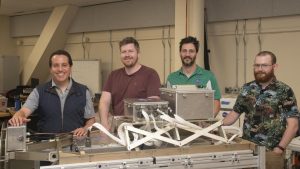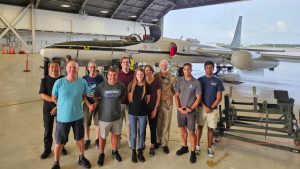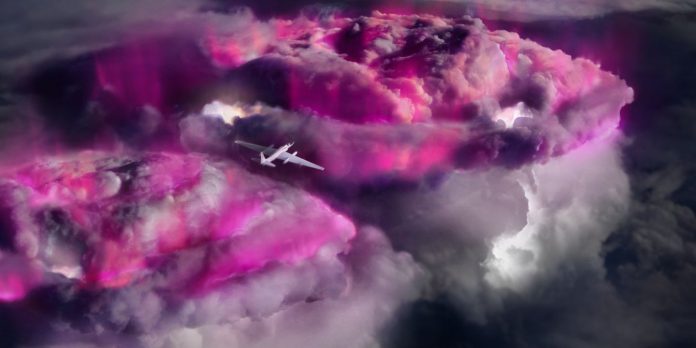HUNTSVILLE – Researchers from the Earth System Science Center at the University of Alabama in Huntsville have partnered with atmospheric scientists from the Marshall Space Flight Center to make groundbreaking discoveries about gamma-ray emissions from thunderstorms.
Once considered rare and short-lived, these high-energy bursts are now revealed to be far more dynamic, extensive and frequent than previously thought, particularly in tropical regions, according to the team’s findings, featured in the international science journal Nature.

and designer of the FEGS instrument from NASA Marshall Space Flight Center (green shirt); and
partners from the University of Bergen and Sandia National Laboratories working on the FEGS
instrument package. (Courtesy NAS/Genaro Vavuris)
Dr. Monte Bateman, Dr. Daniel Walker, Dr. Hugh Christian and Dr. Phillip Bitzer of the ESSC at UAH teamed with Dr. Timothy Lang, Dr. Christopher Schultz and Dr. Mason Quick at MSFC to support the initiative, alongside an international team. Their research stems from the Airborne Lightning Observatory for Fly’s Eye Geostationary Lightning Mapping Simulator and Terrestrial Gamma-ray Flashes (ALOFT) campaign, conducted over Florida, the Gulf of Mexico and Central America during the summer of 2023.
During the 10 flights, 130 transient gamma-ray events were observed, including 10 glow bursts, 96 Terrestrial Gamma-ray Flashes and 24 Flickering Gamma-ray Flashes, a newly identified phenomenon that bridges the gap between the longer-lived glows and the impulsive short-lived TGFs.
The study fundamentally alters our understanding of gamma-ray glow activity in thunderstorms. Instead of brief, stationary bursts, rapid and dynamic emissions were detected, similar to the bubbling of a boiling pot. These data allowed scientists, for the first time, to observe gamma rays emitted across vast storm areas, sometimes covering thousands of square kilometers and persisting for hours.
UAH provided instrumentation crucial to the success of this project. Bitzer, a lightning expert and associate professor in the Department of Atmospheric and Earth Science, provided essential insights into the link between these high-energy emissions and storm structures, advancing the understanding of the mechanisms behind them.
Throughout the campaign, researchers used real-time, one-second-resolution data downlinked mid-flight that enabled pilots to repeatedly revisit glowing thunderclouds. The innovative approach offered scientists an unprecedented view into the temporal and spatial nature of these emissions.
Notably, on July 24, 2023, a flight path over a mesoscale convective system in Campeche Bay in the Gulf of Mexico showed emissions with fluxes reaching up to 12 times the background level, sustained over a remarkable three-hour observation period.

Marshall Space Flight Center, NASA Goddard Space Flight Center and Naval Research
Laboratory in front of NASA’s Lockheed ER-2 High-Altitude Airborne Science Aircraft. (Courtesy NASA Goddard Space Flight)
UAH’s team provided flight instrumentation essential to determining the energetics within the storms. The Airborne Electric Field Mills were designed, calibrated and maintained by UAH scientists as well as ESSC engineers Mike Stewart, Scott Podgorny and David Corredor. These instruments measure the strength of the storm’s electric field as well as the lightning activity within.
The Electric Field Change Meter, also designed by UAH, is used to monitor the changes in the electric field to indicate lightning stroke strength and polarity. These instruments allowed the team to understand the strength of the electrical generator in the thunderstorm and the magnitude of the changes in the electric field due to discharges.
This is an important consideration when trying to understand how large an electric field, over how much depth, is needed to accelerate electrons to the point that they become capable of producing gamma rays.
UAH scientists, in collaboration with the MSFC, played a critical role in the ALOFT campaign. Because of the cooperative agreement between UAH and NASA, interagency collaboration is at the forefront of this relationship.
NASA and UAH scientists worked hand-in-hand in the field and in the office to facilitate a successful field campaign as well as to analyze and interpret the multitude of data. Also involved in the research were UAH graduate students from the Department of Atmospheric and Earth Science.
Don’t miss out! Subscribe to our email newsletter to have all our smart stories delivered to your inbox.



